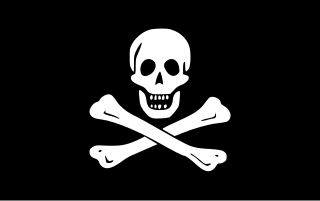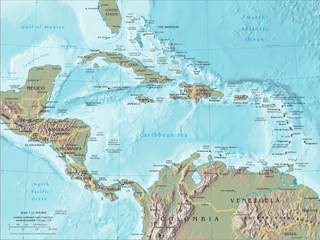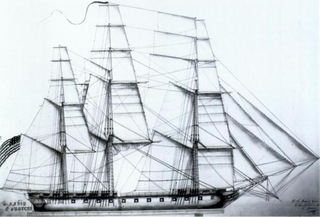Related Research Articles

Piracy is an act of robbery or criminal violence by ship or boat-borne attackers upon another ship or a coastal area, typically with the goal of stealing cargo and other valuable goods. Those who conduct acts of piracy are called pirates, vessels used for piracy are pirate ships. The earliest documented instances of piracy were in the 14th century BC, when the Sea Peoples, a group of ocean raiders, attacked the ships of the Aegean and Mediterranean civilisations. Narrow channels which funnel shipping into predictable routes have long created opportunities for piracy, as well as for privateering and commerce raiding.

The era of piracy in the Caribbean began in the 1500s and phased out in the 1830s after the navies of the nations of Western Europe and North America with colonies in the Caribbean began combating pirates. The period during which pirates were most successful was from the 1660s to the 1730s. Piracy flourished in the Caribbean because of the existence of pirate seaports such as Port Royal in Jamaica, Tortuga in Haiti, and Nassau in the Bahamas. Piracy in the Caribbean was part of a larger historical phenomenon of piracy, as it existed close to major trade and exploration routes in almost all the five oceans.

The USS Enterprise was a schooner, built by Henry Spencer at Baltimore, Maryland, in 1799. Her first commander thought that she was too lightly built and that her quarters, in particular, should be bulletproofed. Enterprise was overhauled and rebuilt several times, effectively changing from a twelve-gun schooner to a fourteen-gun topsail schooner and eventually to a brig. Enterprise saw action in the Caribbean, the Mediterranean, and the Caribbean again, capturing numerous prizes. She wrecked in July 1823.

The Mediterranean Squadron, also known as the Mediterranean Station, was part of the United States Navy in the 19th century that operated in the Mediterranean Sea. It was formed in response to the First and Second Barbary Wars. Between 1801 and 1818, the squadron was composed of a series of rotating squadrons. Later, squadrons were sent in the 1820s to the 1860s to suppress piracy, primarily in Greece and to engage in gunboat diplomacy. In 1865 the force was renamed the European Squadron.

The third USS Alligator was a schooner in the United States Navy.

The Golden Age of Piracy is a common designation for the period between the 1650s and the 1730s, when maritime piracy was a significant factor in the histories of the North Atlantic and Indian Oceans.

Charles Gibbs was the pseudonym of an American pirate, born James D. Jeffers. Jeffers was one of the last active pirates in the Caribbean during the early 19th century, and was among the last persons to be executed for piracy by the United States.

The action of 18 March 2006 occurred when two United States naval vessels were attacked by pirates. The U.S. ships were part of Combined Task Force 150.

The action of 28 October 2007 was part of Operation Enduring Freedom - Horn of Africa, the military operation defined by the United States for combating terrorism in the Horn of Africa. The incident occurred when United States Navy units acted to interdict piracy in the region.
The capture of the schooner Bravo was a naval battle fought in 1819 between United States Revenue Cutter Service cutters and one of Jean Lafitte's pirate ships.

The capture of the sloop Anne was the result of a naval campaign carried out by an alliance between the Spanish Empire forces in Puerto Rico, the Danish government in Saint Thomas and the United States Navy. The powers pursued Roberto Cofresí's pirate flotilla in March 1825 because of the economic losses suffered by the parties to the pirates, as well as diplomatic concerns caused by their use of the flags of Spain and Gran Colombia which menaced the fragile peace between the naval powers. Several of those involved had been attacked by the freebooters. Among the diplomatic concerns caused by Cofresí was a robbery carried out by several of his subordinates, the catalyst of an incident that threatened war between Spain and the United States known as "The Foxardo Affair", eventually leading to the resignation of his rival, pirate hunter David Porter.

The action of 9 November 1822 was a naval battle fought between the United States Navy schooner USS Alligator and a squadron of three pirate schooners off the coast of Cuba during the Navy's West Indies anti-piracy operation. Fifteen leagues from Matanzas, Cuba, a large band of pirates captured several vessels and held them for ransom. Upon hearing of the pirate attacks, Alligator under Lieutenant William Howard Allen rushed to the scene to rescue the vessels and seize the pirates.

The West Indies Squadron, or the West Indies Station, was a United States Navy squadron that operated in the West Indies in the early nineteenth century. It was formed due to the need to suppress piracy in the Caribbean Sea, the Antilles and the Gulf of Mexico region of the Atlantic Ocean. This unit later engaged in the Second Seminole War until being combined with the Home Squadron in 1842. From 1822 to 1826 the squadron was based out of Saint Thomas Island until the Pensacola Naval Yard was constructed.
The first USS Greyhound was a U.S. Navy, two-masted schooner in commission from 1822 to 1824.
The first USS Terrier was a United States Navy schooner in commission from 1823 to 1825. It was part of the West Indies squadron and served transporting U.S. sailors, marines and supplies to the pirate infested waters of the Caribbean and was used to search out and attack pirate ships and pirate strongholds.

The West Indies Anti-Piracy Operations were a series of military operations and engagements undertaken by the United States Navy against pirates in and around the Antilles. Between 1814 and 1825, the American West Indies Squadron hunted pirates on both sea and land, primarily around Cuba and Puerto Rico. After the capture of Roberto Cofresi in 1825, acts of piracy became rare, and the operation was considered a success, although limited occurrences went on until slightly after the start of the 20th century.

Operation Ocean Shield was NATO's contribution to Operation Enduring Freedom – Horn of Africa (OEF-HOA), an anti-piracy initiative in the Indian Ocean, Guardafui Channel, Gulf of Aden and Arabian Sea. It follows the earlier Operation Allied Protector. Naval operations began on 17 August 2009 after being approved by the North Atlantic Council, the program was terminated on 15 December 2016 by NATO. Operation Ocean Shield focused on protecting the ships of Operation Allied Provider, which transported relief supplies as part of the World Food Programme's mission in the region. The initiative also helped strengthen the navies and coast guards of regional states to assist in countering pirate attacks. Additionally, China, Japan and South Korea sent warships to participate in these activities.

Bartolomeu Português (1623–1670) was a Portuguese buccaneer who attacked Spanish shipping in the late 1660s. Português was responsible for the creation of the first "Pirate's Code".
USS Ferret was a two masted schooner, the third U.S. Navy vessel to bear this name, and was purchased 20 December 1822 at Baltimore, Maryland and commissioned early in 1823, with Lieutenant R. Henley in command. It was the first U.S. naval ship commanded by the famous naval hero David Farragut. Ferret served transporting U.S. sailors, marines and supplies to the pirate infested waters of the Caribbean and was used to search out and attack pirate ships and pirate strongholds for a little more than two years when her career was cut short when the vessel capsized in a gale force storm off the coast of Cuba.
The USS Weasel was a three-gun schooner in the United States Navy.
References
- ↑ Konstam, Angus. Scourge of the Seas: Buccaneers, Pirates and Privateers. Oxford: Osprey Publishing, 2007. (pg. 225) ISBN 1-84603-211-3
- ↑ Maclay, Edgar Stanton. A History of the United States Navy from 1775 to 1901. Vol. II. New York: D. Appleton and Company, 1906. (pg. 37-38)

